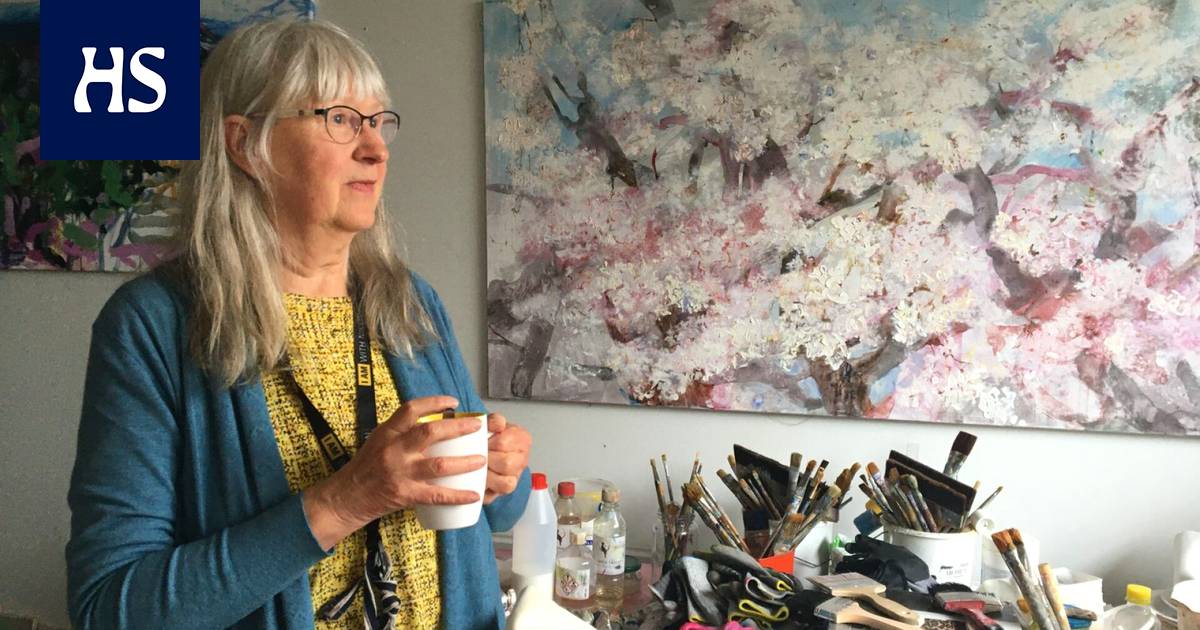It feels like living in a house with a yard and thieves inside. From the lottery win, says artist Paula Holopainen. Now he talks about his amazing experiences at Villa Söderbo in Vantaa.
Lonely the feather hovers on the floor to a point where there has sometimes been a chair. Now there is no furniture left in the apartment.
The former life of the house as an artist’s apartment is no longer reminiscent of paint splashes on the floor moldings. The windows offer a beautiful river view, but no one looks at it here anymore.
There was a time when Paula Holopainen watched this landscape every morning. For more than 20 years, Villa Söderbo was home to visual artist Paula Holopainen, 74, and cohabiting To Hannu Kivimäki69.
Then one day a man appeared at the door and handed the couple an official eviction order. The city of Vantaa had decided that Villa Söderbo would be used for other purposes.
“Yes, we knew the eviction was coming and we had time to get used to the idea. Still, it angered us that we had to leave, ”says Holopainen.
Villa Söderbon was built as a home by miller Ernst Söderling. The house was completed in 1939. The city of Vantaa bought the house from Söderling in 1987.
Itthat Holopainen and Kivimäki ended up living in a house was a lucky coincidence. In 1996, Kivimäki was renovating the artist house Gjutars. Kivimäki, who is homeless, would ask the builder if he would happen to know of an empty cabin.
At this point, Villa Söderbo had been empty for a while and was in quite poor condition.
“We agreed that I could move to Söderbo upstairs if I renovated it at the same time,” says Kivimäki.
Downstairs came the premises of the Arkki kindergarten next door. However, the kindergarten was not on the premises for a long time.
Paula Holopainen suggested to the city that she set up an artist space downstairs. It suited the city. At that time, Villa Söderbo became both a home and a job for Holopainen.
Paula Holopainen and Hannu Kivimäki lived in Villa Söderbo for more than 20 years.
For the artist the house connecting home and work was ideal. There were paintings in every corner downstairs. One of the rooms was a storage room, one was a work space, and the kitchen was computer-based.
“I have a big art library, so it took up space, too.”
The upstairs served as an apartment. The rent for the apartment was not high, because in the early days, the City of Vantaa Cultural Office supported those living in the artist’s apartment. Subsequently, the support was stopped and the rent for the apartment tripled.
“People admired the apartment, but yes, it probably also aroused the envy of other artists,” Holopainen thinks.
There has always been a shortage of studio and exhibition space in Vantaa, so getting into the artist’s house was a kind of lottery win.
Although the house served as a private home, I got to see it from time to time. According to Holopainen, the doors of the house were open to those interested almost every year, either only or because of art exhibitions.
“I also taught at an adult college, and Söderbo was the base for river painting courses, among other things.”
Paula Holopainen’s study at Villa Söderbo. The name of the large painting shown in the picture is Mars, the red planet.
Just however, living in the center of Tikkurila was not an idyll. The sheltered location just 500 meters from Tikkurila station attracted all kinds of walkers to the yard.
In the 21st century, ravines were held in the adjacent Silkkitehtaa premises, and participants regularly got lost in the courtyard of Söderbo.
“They fucked in our yard and raged and muttered,” says Holopainen.
The apartment was also robbed several times.
“Once the apartment was visited at night and a camera was taken right next to me. I didn’t wake up at all. In the morning, Hannu wondered where the money left on the table was and only then did we notice the robbery. ”
When the apartment was last looted, the thieves took the Holopainen jewelry.
“I haven’t used any jewelry since. I noticed that I didn’t need them. ”
Holopainen was calm about the robberies and did not upset her sense of security or desire to live in the house.
“I was amazed when there was a call from the social side that help was available.”
Villa Söderbo has two kitchens, one downstairs and one upstairs.
When Villa Söderbo was completed in 1939, was a riverside quiet area. It is surrounded by a spacious field landscape and a small dirt road led to the house. There were few buildings in the area other than the Silk Factory.
The house was built as a home for the miller Ernst Söderling. The house was completed next to a previously built mill.
According to the host, the mill was known as the Söderling mill, although officially its name was Tikkurila’s Wheat Mill, Dickursby Vetekvarn. The mill ceased operations in 1956.
The Söderling mill, completed in 1935, is shown on the left. Next to it are the buildings of Tikkurila Silkkitehtaa. Villa Söderbota has not been built yet.
Today, the mill is called the Wine Mill. The name was given Wine Mountain, which established a summer café in the mill in the 1990s. Dances and summer theater performances were held in the courtyard of the popular café during the summer. The mill has also been empty since 2018, when the lease of the cafe owners was terminated.
The City of Vantaa put both buildings up for sale in 2020. However, the need to renovate the protected buildings was questioned by potential buyers. Soil stability also raised questions.
The city of Vantaa commissioned a stability report on Villa Söderbo and the mill, which was completed this spring. It states that Villa Söderbota and the mill have not been built on stable ground and that there is a risk that buildings begin to move towards the river.
Read more: These two house treasures of the 1930s are in a threatening situation: They may slide into the river in Vantaa
In 1950, miller Ernst Söderling’s son Erik and his family moved upstairs. Two rooms and a toilet were built in the cold attic. The closets still have 50’s plywood flat doors.
The results amaze Holopa and Kivimäki. They are amazed at how a house that has been firmly in place for over 80 years could suddenly be in danger of moving.
“The house was quite stable when we lived in it. If you put the pen on the floor, it wouldn’t turn anywhere, ”says Holopainen.
“Wondering if the city of Vantaa is going to keep the house empty for so long that it will rot. Then you can build apartment buildings instead, ”Holopainen thinks.
The Holopainen themselves have nothing against apartment buildings, they moved with Kivimäki themselves when the eviction from Söderbo came. But Söderbo is rare in Vantaa.
The Vantaa City Museum has considered the villa worthy of protection for both cityscape and building and local historical reasons.
Holopainen’s desire to protect the building is perhaps more personal. There are many wonderful memories associated with the building.
“I am an adaptable person, but sometimes I miss the proximity of the river. It was nice to watch. I hope the house is not lost. ”
Read more: Bengt Lindström began renovating a historic family home – then he measured the floor and realized he had entered an all-time construction site
Read more: Historic inn in a magnificent environment sinks to the ground in Vantaa – Now the owners are facing a demanding construction site that is in a hurry in addition to everything
Read more: There had to be no point in this renovation project – When Selena Pesonen bought an old barn as her home, an acquaintance urged to burn all the rubbish
#Vantaa #Paula #Holopainen #home #jealous #lottery #win #time #didnt #kind #crowd #break #repeatedly









